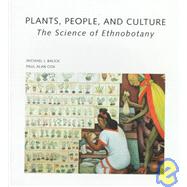
Plants, People and Culture : The Science of Ethnobotany, a Scientific American Library Book
by Balick, Michael J.; Cox, Paul Alan-

This Item Qualifies for Free Shipping!*
*Excludes marketplace orders.
Rent Textbook
New Textbook
We're Sorry
Sold Out
Used Textbook
We're Sorry
Sold Out
eTextbook
We're Sorry
Not Available
How Marketplace Works:
- This item is offered by an independent seller and not shipped from our warehouse
- Item details like edition and cover design may differ from our description; see seller's comments before ordering.
- Sellers much confirm and ship within two business days; otherwise, the order will be cancelled and refunded.
- Marketplace purchases cannot be returned to eCampus.com. Contact the seller directly for inquiries; if no response within two days, contact customer service.
- Additional shipping costs apply to Marketplace purchases. Review shipping costs at checkout.
Summary
The inventive use of plants by indigenous shipwrights and weavers provides further evidence of the botanical sophistication of indigenous peoples, as does the shaman's use of plants to provide doorways into the other world - a world populated by both angelic and demonic beings. Although claims for such plants have sometimes been attributed to superstition, studies of these plants have revealed a plethora of novel compounds with potent neuropsychological impacts. Such compounds hold the promise of providing new treatments for psychiatric illness, but also the threat of societal disruption if their illegal traffic continues to grow.
The view that plants themselves can be sacred leads to a startling reconsideration of the role of indigenous people in conservation. The authors, who have both spent decades in the tropics, persuasively argue that rain forest conservation can best be accomplished by learning from, rather than opposing, indigenous peoples and their concerns.
Author Biography
Table of Contents
| Preface | |
| People and Plants | p. 1 |
| Plants That Heal | p. 25 |
| From Hunting and Gathering to Haute Cuisine | p. 63 |
| Plants as the Basis for Material Culture | p. 99 |
| Entering the Other World | p. 145 |
| Biological Conservation and Ethnobotany | p. 179 |
| Suggested Reading | p. 209 |
| Sources of Illustrations | p. 219 |
| Index | p. 221 |
| Table of Contents provided by Blackwell. All Rights Reserved. |
An electronic version of this book is available through VitalSource.
This book is viewable on PC, Mac, iPhone, iPad, iPod Touch, and most smartphones.
By purchasing, you will be able to view this book online, as well as download it, for the chosen number of days.
Digital License
You are licensing a digital product for a set duration. Durations are set forth in the product description, with "Lifetime" typically meaning five (5) years of online access and permanent download to a supported device. All licenses are non-transferable.
More details can be found here.
A downloadable version of this book is available through the eCampus Reader or compatible Adobe readers.
Applications are available on iOS, Android, PC, Mac, and Windows Mobile platforms.
Please view the compatibility matrix prior to purchase.